

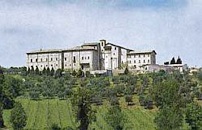
Unless otherwise stated, the images on this page
are from the website of “Todi’s Country Real Estate”
The abbey is some 3 km north of Giano dell’ Umbria. It seems to have been established early in the 6th century, when Bishop John of Spoleto translated the relics of St Felix of Civitas Martana here from San Felice, in what is now Massa Martana. (For the historical context, see the page on Early Christian Civitas Martana).
According to Ludovico Jacobilli, a community of Benedictine monks founded an abbey on this site in 950. The present church (late 11th century) contains many ancient fragments.
Pope Gregory XI subordinated to the Abbazia di Sassovivo, Foligno in 1373.
The complex had become decadent by 1450, when Pope Nicholas V transferred it to a community of Augustinian hermits. They restored the church in period 1452-81.
The community was suppressed in 1798. The Congregation of the Most Holy Cross and Passion of Our Lord Jesus Christ settled here in the period 1803-10 followed by the Missionari del Preziosissimo Sangue in 1815. They were expelled in 1860 but returned in 1937.
Later modifications were reversed during a restoration in 1955-8 and the church was restored again in 1992, after the Commune of Spoleto formally transferred ownership to the Missionari del Preziosissimo Sangue.
The church is sometimes open for concerts.
Exterior
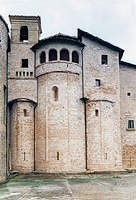
This image is from the website of
The facade, which was elevated in the 16th century, has a trifore window that was probably reinstated after the modification. The columns in this window may date to the 5th century.
Scenes from the Life of St Felix (18th century)
These frescoes in the cloister are attributed to Liborio Coccetti.
Interior
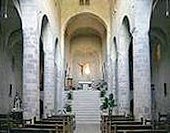
The church has a nave with a barrel vault, two aisles and a raised presbytery over the crypt.
Crypt
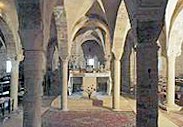
The crypt has a nave and two aisles, separated by columns (late 11th century).
[Two pilasters with capitals inscribed with animal reliefs]
The crypt houses the sarcophagus (ca. 600) of St Felix of Civitas Martana. It belongs to a group that seems to have been manufactured in Spoleto in the 5th century, two of which are known housed the relics of bishop saints: this one and the sarcophagus of St Juvenal in the Duomo of Narci. They are characterised by a low relief on one side that consists of a rectangle flanked by two triangles and then by two arches with architraves. A wide variety of dates has been proposed for this group of sarcophagi: that suggested here was suggested by Mario Sensi (referenced below, at p. 90):
-
“The sarcophagus at Foligno which was contemporary with those from Giano, Narni and Spoleto, is assignable on the basis of [the shared] decorative motif to the 6th or 7th century” (my translation).
The relics were, apparently, rediscovered in 1783, when a relic of the saint was translated to Spello (see the page on St Felix, Spello).
Art From the Church
San Felice Dossal (ca. 1250)

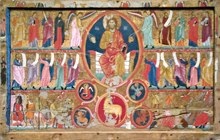

This dossal, which is the autograph work of the Maestro di San Felice di Giano, includes scenes from the martyrdom of St Felix. It is now in the Galleria Nazionale, Perugia.
In the centre of the dossal, Christ sits in judgment in a mandorla, with censing angels to the sides. Full-length figures occupy two registers to each side:
-
✴the top register contains figures of SS Andrew, Simon and Paul and the Virgin to the left; and SS John the Baptist, Peter, James and Philip to the right; and
-
✴the middle register contains figures of prophets.
Tondi below the figure of Christ contain the Lamb of God and the symbols of the Evangelists, with scenes from the martyrdom of St Felix to the sides.
Madonna del Succorso (1494)
This panel, which is dated by inscription, is attributed to Francesco Melanzio. [It is now inside the abbey].





